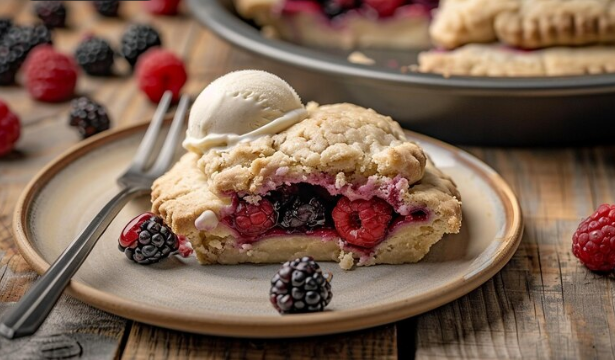Why is it called cobbler? A lot, especially for the cozy cobbler. This dessert is a staple in American and British homes. It features baked fruit with a crusty topping, unlike the streusel-like crisp and crumble. Unique to the cobbler is its biscuit, dumpling, or batter topping that rises beautifully when baked.
Imagine the aroma of juicy fruits bubbling under a soft, doughy top. Cobblers aren’t just easy; they’re adaptable. They work with any seasonal fruit, from summer peaches to fall apples.
This exploration will dive into cobblers’ layers. We’ll prepare you to bake or simply savor this delightful dish. From its origins to its place on modern menus, understanding cobblers is like enjoying a slice of sweetened history. Let’s start baking!
Historical Background
The Origins of Cobbler
Cobblers have warmed hearts since the 19th century. Their story starts earlier in British and American culinary traditions. It’s intriguing how a simple dessert of dough and fruit became so beloved.
The term « cobbler » first appeared in the 1850s in America. It may derive from the old English cobeler, meaning « wooden bowl ». Another theory links it to the biscuit dough’s resemblance to cobblestone streets.
By the mid-19th century, cobblers were popular in American homes, especially in the South. They featured fruit left from the harvest, tucked into pots lined with thick dough. This created a hearty, rustic dish perfect for families or community potlucks.
The evolution of the cobbler reflects broader historical shifts. Post-Civil War, the simple needs of flour, butter, and fruit made it economical. Its recipe could adapt based on local availability, turning it into a regional flavor canvas.
Different regions added their own twists, creating a variety of cobblers nationwide. In Texas, peach cobblers might come with hard sauce. In Georgia, blueberry cobblers highlight local produce.
This rich history not only influences contemporary tastes but also enriches the cobbler’s narrative. As we uncover its past, we appreciate each bite more, knowing it’s not just dessert—it’s a baked-in story. Next time you enjoy a cobbler, remember, you’re tasting culinary history.
Comparative Analysis with Similar Desserts
Cobbler vs. Crisp vs. Crumble
The Unique Cobbler
When you compare a cobbler with its dessert cousins, it stands out due to its distinctive, biscuit-like topping. This is applied spooned or dropped over the fruit, creating a rugged, cobblestone look—hence the name. What sets cobbler apart is the dough’s soft, cakey texture, providing a comforting contrast to the juicy fruit beneath.
The Crispy Appeal of Crisps
Crisps feature a golden, crumbly topping made from flour, oats, sugar, and butter. This mixture is scattered over the fruit to bake into a crisp texture, introducing a delightful crunch that contrasts with the softness of the fruit below. Popularized in the United States during the 20th century, crisps are cherished for their simplicity and the sensory contrast they offer.
The Simple Charm of Crumbles
Crumbles are similar to crisps but typically do not include oats, resulting in a finer, sandier texture. They emerged in Britain during World War II as an economical substitute for pies, with a basic topping of flour, sugar, and butter, occasionally enhanced with nuts or spices like cinnamon. The crumble’s simplicity and the nostalgic warmth it brings make it a beloved choice in many households.
Understanding the distinct characteristics of cobblers, crisps, and crumbles not only enriches our baking vocabulary but also deepens our appreciation for each dessert’s unique qualities. Whether enjoying the doughy comfort of a cobbler, the crispy delight of a crisp, or the rich, sandy texture of a crumble, each dessert offers a special narrative and place in the culinary landscape.
Modern Variations and Recipes
Contemporary Cobbler Creations
Versatility in Ingredients
Cobblers have evolved from their traditional roots, becoming a versatile element in modern culinary arts. Chefs and home bakers now experiment with various ingredients, transforming this classic dessert into a showcase of creativity. The adaptability of cobblers is evident as you can modify the traditional recipe to incorporate fruits like mangoes or blackberries, or even combine multiple fruits for complex flavors. Toppings too have evolved from the classic biscuit to inventive choices like cinnamon roll dough or puff pastry, each enhancing the dish’s texture and taste.
Innovative Twists on a Classic
One of the most intriguing adaptations is the savory cobbler, which replaces the typical sweet filling with combinations such as tomato and cheese, topped with herbed biscuits. This variant shifts the cobbler from dessert to a delightful main course, ideal for those who enjoy the comfort of a biscuit topping without the sweetness. Additionally, incorporating global flavors like cardamom or saffron into the fruit mixture introduces exotic spices, adding a layer of complexity and cultural fusion to the dish.
For those keen to explore these innovative cobbler recipes or seeking guidance on perfecting the dessert, culinary resources like Food52 offer comprehensive guides and professional tips. These platforms are excellent for both novice bakers and seasoned chefs aiming to broaden their dessert skills.
Embracing modern cobbler variations not only revitalizes an old favorite but also fosters continual culinary creativity. Whether you prefer classic recipes or adventurous new creations, the possibilities with cobblers are boundless. Why not explore something new in your kitchen today?

